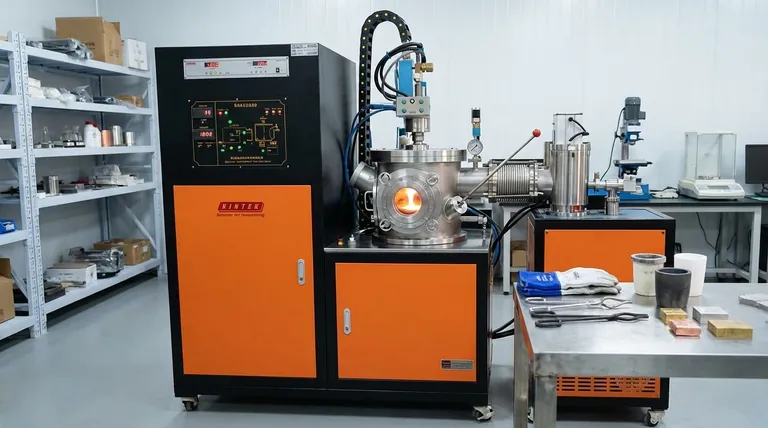间接电弧炉是一种电炉,其中物料在不作为电路一部分的情况下被加热。电弧在位于物料上方的两个电极之间产生,产生的强烈热量主要通过辐射(类似于烤箱的炙烤)传递到下方的物质上。
间接电弧炉的核心区别在于其加热方法。与将电流直接通过物料的直弧炉不同,这种炉子通过上方辐射加热,提供了一种更洁净、更受控的工艺,非常适合特殊应用。
核心原理:辐射加热
间接电弧炉的运行取决于其产生和传递热能的方式。其设计侧重于控制和纯度,而非其他炉型的原始功率。
电弧的形成方式
在两个或多个石墨电极之间的空间中产生强烈的电弧。这些电极通常水平放置,位于待加热物料(称为“炉料”)的正上方。
电流从一个电极流向另一个电极,形成持续的高温电弧。物料本身从未直接接触这个电路。
辐射热的作用
电弧的温度可达到数千度。这种巨大的能量向外辐射,主要向下照射到炉料表面。内衬耐火材料的炉顶和炉壁将额外的热量反射到炉料上,使其自上而下熔化。
为确保均匀加热,许多间接电弧炉被设计成圆柱形或“摇摆式”。这使得炉子可以轻微搅动或旋转,使熔融的物料混合,并将新表面暴露在辐射热下。
这对材料纯度的影响
由于电流不通过炉料,电极污染的风险大大降低。这使得间接电弧工艺异常洁净,这在生产高纯度金属或成分必须精确的特定有色合金时至关重要。

主要区别:间接电弧炉与直弧炉
要理解间接电弧炉,需要将其与其更常见的直弧炉(DAF)进行比较。
电流路径
在间接电弧炉中,电流路径仅为电极到电极。
在直弧炉中,电流从电极流过物料本身,然后通过炉底的导电炉床流出。物料是电路的活动组成部分。
热传递机制
间接电炉几乎完全依赖电弧向炉料的辐射。
直弧炉使用电弧的辐射和电阻加热的组合,因为巨大的电流直接通过金属炉料。这种双重机制赋予了它如此高的功率和速度。
常见应用
间接电弧炉最适合用于较小、专业的任务。这包括熔炼铜、黄铜和青铜等有色金属,以及在铸造厂或实验室环境中生产高质量的合金钢。 直弧炉是高产量钢铁生产的行业标准,特别是用于熔化废金属。它们的规模和效率在散装加工方面是无与伦比的。
理解权衡
没有一种技术在所有情况下都是最优秀的。在炉型之间的选择完全取决于操作目标、物料和所需的规模。
优点:温度均匀性和控制
辐射加热方法,特别是与摇摆机构结合使用时,在熔融料池中提供了出色的温度均匀性。这带来了高度一致的最终产品,证明了其在结果必须可重复的科学和研究应用中的价值。
缺点:热效率较低
电弧的大部分热量辐射到炉顶和炉壁,而不是直接进入炉料。这种热量损失使得间接电弧炉的能源效率低于直弧炉,因为直弧炉的能量是在炉料内部产生的。
缺点:熔炼速度较慢
由于热传递不够直接,与相同功率等级的 DAF 相比,熔炼时间通常更长。这限制了其在高吞吐量、大规模生产中的应用。
根据您的目标做出正确的选择
选择正确的炉子技术是基于您对纯度、产量和材料类型的特定操作需求所做的关键决定。
- 如果您的主要重点是从废料进行大规模钢铁生产: 直弧炉是正确的选择,因为它在散装熔炼方面具有卓越的速度和热效率。
- 如果您的主要重点是高纯度有色合金(青铜、黄铜): 间接电弧炉提供了必要的控制,并防止了电极污染。
- 如果您的主要重点是研究或小批量铸造工作: 间接电弧炉的稳定、均匀的加热使其成为实现精确冶金特性的理想设备。
最终,选择合适的工具需要清楚地了解您的工艺是优先考虑原始功率和效率,还是优先考虑精度和纯度。
摘要表:
| 特性 | 间接电弧炉 | 直弧炉 |
|---|---|---|
| 加热方法 | 上方电弧的辐射热 | 电阻加热 + 辐射(电流通过物料) |
| 电流路径 | 电极到电极 | 电极 → 物料 → 炉床 |
| 主要用途 | 高纯度有色金属、合金、研发 | 废料大规模钢铁生产 |
| 主要优点 | 卓越的控制和材料纯度 | 高功率和熔炼速度 |
| 主要缺点 | 热效率较低,熔炼速度慢 | 控制力较弱,有污染风险 |
您的实验室或铸造厂需要精确的热处理吗?
在 KINTEK,我们专注于提供高质量的实验室设备,包括专为受控熔炼和合金生产而定制的熔炉。我们的解决方案可帮助您实现对研究和专业制造至关重要的纯度和一致性。
让我们讨论您的应用。 立即联系我们的专家,找到满足您需求的完美熔炉。
图解指南




















